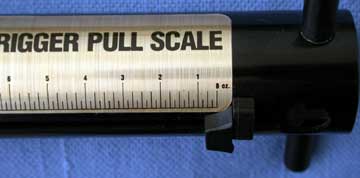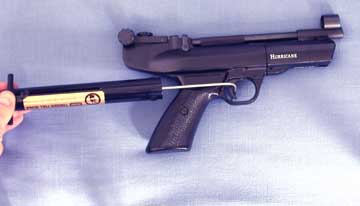by B.B. Pelletier
Today’s post answers a question from last week. Matt asks:
“Can you explain trigger pull and how the number of pounds is come to? I’ve seen different guns listed as low as 2lbs and as high as 12lbs, but it doesn’t mean anything to me.
Trigger-pull is a measure of force
The force exerted on the trigger to get the sear to release, or (in some airguns) to get the valve to open, is called trigger-pull. Popular belief says the lightest trigger-pull possible is the best, but that’s not always true.
The bottom line is control of the gun
The more you can determine exactly when a gun will fire, the better your chances of hitting the target. That’s not all that’s involved, of course, but controlling the moment of firing is very important. Less-experienced shooters are better off being surprised when the gun goes off. That way, they won’t flinch involuntarily just before sear release. As a shooter gains experience with a certain gun, he will begin to notice when it’s ready to fire, and this will refine into a positive knowledge of EXACTLY when the gun is about to fire. When you know this, your accuracy improves measurably.
A trigger that’s too light is dangerous!
I have seen shooters fire a gun just by picking it up! Their fingers automatically seek the trigger, and they’re used to some resistance before release, so a true “hair trigger” that lets go at 10 grams of resistance is beyond their experience. Some can’t feel the trigger blade on their fingertip before the gun fires.
A heavy trigger can work very well
I have an 1875 trapdoor Springfield rifle with a 5 lb. trigger-pull. Compared to the triggers found in modern PCP air rifles, that’s way too heavy. Yet, this trigger poses no problem for perfect accuracy. Why? Because I know exactly when it’s going to release. This is one of the most predictable triggers I own. Conversely, I have a Swiss Schmidt-Rubin rifle with a trigger-pull of less than a pound that I haven’t gotten used to yet. That rifle is much harder to shoot well.
Some PCP triggers are light but they don’t have a definite release point, so you are always guessing when the gun is going to fire. Others release the same, time after time. They’re the ones you can usually shoot the best. In general, I’ve found Daystate triggers to be very vague and ambiguous. They’re light, but not crisp. Falcon triggers are usually very crisp and repeatable. Of course, Falcon just changed hands this year, so it remains to be seen whether the new triggers will be as good.
Trigger creep can throw you off
The Asian rifles from Sam Yang often have a lot of creep in the trigger. Creep is movement in the loaded (hard-to-pull) stage of the trigger. This can be the first stage in a single-stage trigger or the second stage in a two-stage trigger. I find Shin Sung triggers to be better, but they also have some creep. AirForce triggers usually have a small amount of creep in the second stage, but it is very predictable, so it doesn’t affect the pull.
Top-grade target guns always have two-stage triggers with zero creep in the second stage. Second-tier target guns usually have some creep. The Drulov DU-10 target pistol has a wonderful trigger, but there is always a small bit of creep in it.
How is trigger-pull measured?
Trigger-pull is measured either by a resistance gauge or by actual weights. In formal air pistol competition, where the minimum trigger-pull weight of 500 grams is specified in the rules, each gun is cocked and must pick up a weight of 500 grams (about 1.1 pounds) with the bar resting on the trigger. If it does that without firing, the officials don’t care where the trigger breaks! Gun testers like me use resistance gauges to measure exactly where the trigger releases. It’s not always at the same point on some triggers!

Pulling on the gauge slides a marker that comes to rest at the point where the tension is released (trigger fires the gun).

The RCBS trigger-pull gauge is a spring-resistance gauge that measures pull in ounces up to 8 lbs.
A good sporting trigger breaks between 2 lbs. and 5 lbs. It breaks at the same weight every time. A good target trigger for benchrest shooting can be as light at 10 grams. For target shooting, where the shooter holds the gun, a 1-lb. pull is pretty light, though 10-meter air rifle target shooters often go down to 40 or 50 grams or so.
Trigger-pull weight is very personal, so every shooter must determine what is best for himself. As the shooter gains experience, however, he will learn how to adapt to a trigger-pull of almost any weight.
Thanks BB. It got confusing because different sites listed different numbers to the same gun. I appreciate the clarification and I got more than I expected!
Matt
Hi
I just purchased a .22 RWS 350. Is there any reason to use expensive pellets just to break in the gun for a couple of thousand shots? Would good old Daisy Max precisons be OK? I plan to use heavy, high quality pellets for hunting.
Thanks for all the great advice in your blog
Sam V.
You think like me! I would try the Daisys but watch for excessinve dieseling. The 350 magnum is so powerful it may want a heavier pellet than the Daisy. If so, The Gamo magnum pointed pellet are not terribly expensive, though they do cost more than the Daisys.
Just watch the dieseling.
B.B.
On my Gamo after alot of tweaking I got the trigger set at about 40 grams and this is for hunting! I guess it comes down to personal preference if the trigger is set really heavy or light.
Thanks, I’ll try the Gamo magnums.
Sam V.
Hi,after having 6 springers I want to buy a pcp to use it for long range hunting and for target practice.I am thinking of an HW100 and of a theoben rapid mk2.What’s your opinion?What would be the power and number of shots for each rifle?Have you ever tested their accuracy?
Thanks for all the great advice in your blog.
Jerry,
Either rifle is wonderful. But have you considered the new Benjamin Marauder? Same accuracy and great trigger at half the price or less.
Read about it here:
/blog/2009/4/benjamin-marauder-part-4/
B.B.